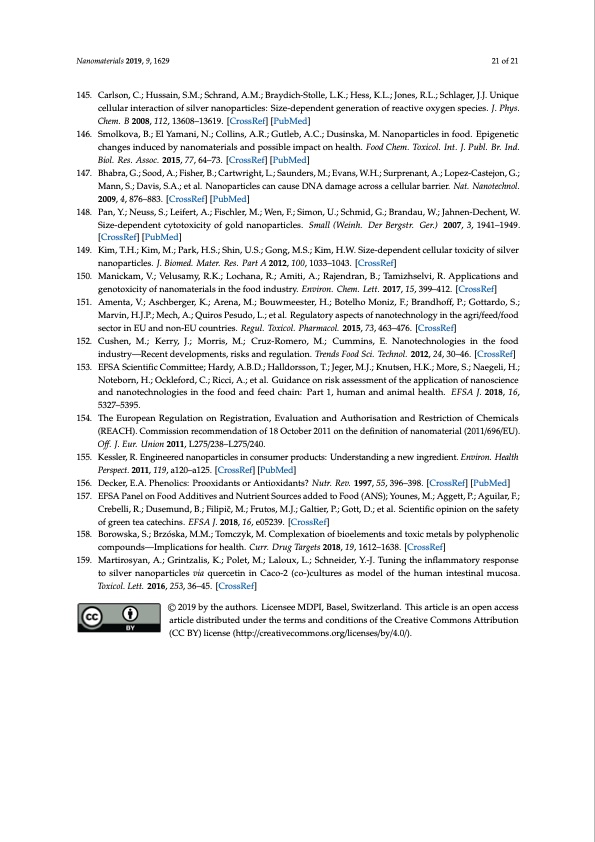
PDF Publication Title:
Text from PDF Page: 021
Nanomaterials 2019, 9, 1629 21 of 21 145. Carlson,C.;Hussain,S.M.;Schrand,A.M.;Braydich-Stolle,L.K.;Hess,K.L.;Jones,R.L.;Schlager,J.J.Unique cellular interaction of silver nanoparticles: Size-dependent generation of reactive oxygen species. J. Phys. Chem. B 2008, 112, 13608–13619. [CrossRef] [PubMed] 146. Smolkova,B.;ElYamani,N.;Collins,A.R.;Gutleb,A.C.;Dusinska,M.Nanoparticlesinfood.Epigenetic changes induced by nanomaterials and possible impact on health. Food Chem. Toxicol. Int. J. Publ. Br. Ind. Biol. Res. Assoc. 2015, 77, 64–73. [CrossRef] [PubMed] 147. Bhabra,G.;Sood,A.;Fisher,B.;Cartwright,L.;Saunders,M.;Evans,W.H.;Surprenant,A.;Lopez-Castejon,G.; Mann, S.; Davis, S.A.; et al. Nanoparticles can cause DNA damage across a cellular barrier. Nat. Nanotechnol. 2009, 4, 876–883. [CrossRef] [PubMed] 148. Pan,Y.;Neuss,S.;Leifert,A.;Fischler,M.;Wen,F.;Simon,U.;Schmid,G.;Brandau,W.;Jahnen-Dechent,W. Size-dependent cytotoxicity of gold nanoparticles. Small (Weinh. Der Bergstr. Ger.) 2007, 3, 1941–1949. [CrossRef] [PubMed] 149. Kim,T.H.;Kim,M.;Park,H.S.;Shin,U.S.;Gong,M.S.;Kim,H.W.Size-dependentcellulartoxicityofsilver nanoparticles. J. Biomed. Mater. Res. Part A 2012, 100, 1033–1043. [CrossRef] 150. Manickam, V.; Velusamy, R.K.; Lochana, R.; Amiti, A.; Rajendran, B.; Tamizhselvi, R. Applications and genotoxicity of nanomaterials in the food industry. Environ. Chem. Lett. 2017, 15, 399–412. [CrossRef] 151. Amenta, V.; Aschberger, K.; Arena, M.; Bouwmeester, H.; Botelho Moniz, F.; Brandhoff, P.; Gottardo, S.; Marvin, H.J.P.; Mech, A.; Quiros Pesudo, L.; et al. Regulatory aspects of nanotechnology in the agri/feed/food sector in EU and non-EU countries. Regul. Toxicol. Pharmacol. 2015, 73, 463–476. [CrossRef] 152. Cushen, M.; Kerry, J.; Morris, M.; Cruz-Romero, M.; Cummins, E. Nanotechnologies in the food industry—Recent developments, risks and regulation. Trends Food Sci. Technol. 2012, 24, 30–46. [CrossRef] 153. EFSAScientificCommittee;Hardy,A.B.D.;Halldorsson,T.;Jeger,M.J.;Knutsen,H.K.;More,S.;Naegeli,H.; Noteborn, H.; Ockleford, C.; Ricci, A.; et al. Guidance on risk assessment of the application of nanoscience and nanotechnologies in the food and feed chain: Part 1, human and animal health. EFSA J. 2018, 16, 5327–5395. 154. The European Regulation on Registration, Evaluation and Authorisation and Restriction of Chemicals (REACH). Commission recommendation of 18 October 2011 on the definition of nanomaterial (2011/696/EU). Off. J. Eur. Union 2011, L275/238–L275/240. 155. Kessler,R.Engineerednanoparticlesinconsumerproducts:Understandinganewingredient.Environ.Health Perspect. 2011, 119, a120–a125. [CrossRef] [PubMed] 156. Decker,E.A.Phenolics:ProoxidantsorAntioxidants?Nutr.Rev.1997,55,396–398.[CrossRef][PubMed] 157. EFSAPanelonFoodAdditivesandNutrientSourcesaddedtoFood(ANS);Younes,M.;Aggett,P.;Aguilar,F.; Crebelli, R.; Dusemund, B.; Filipicˇ, M.; Frutos, M.J.; Galtier, P.; Gott, D.; et al. Scientific opinion on the safety of green tea catechins. EFSA J. 2018, 16, e05239. [CrossRef] 158. Borowska,S.;Brzóska,M.M.;Tomczyk,M.Complexationofbioelementsandtoxicmetalsbypolyphenolic compounds—Implications for health. Curr. Drug Targets 2018, 19, 1612–1638. [CrossRef] 159. Martirosyan, A.; Grintzalis, K.; Polet, M.; Laloux, L.; Schneider, Y.-J. Tuning the inflammatory response to silver nanoparticles via quercetin in Caco-2 (co-)cultures as model of the human intestinal mucosa. Toxicol. Lett. 2016, 253, 36–45. [CrossRef] © 2019 by the authors. Licensee MDPI, Basel, Switzerland. This article is an open access article distributed under the terms and conditions of the Creative Commons Attribution (CC BY) license (http://creativecommons.org/licenses/by/4.0/).PDF Image | Polyphenol-Loaded Nanoparticles in Food Industry

PDF Search Title:
Polyphenol-Loaded Nanoparticles in Food IndustryOriginal File Name Searched:
nanomaterials-09-01629.pdfDIY PDF Search: Google It | Yahoo | Bing
Turbine and System Plans CAD CAM: Special for this month, any plans are $10,000 for complete Cad/Cam blueprints. License is for one build. Try before you buy a production license. More Info
Waste Heat Power Technology: Organic Rankine Cycle uses waste heat to make electricity, shaft horsepower and cooling. More Info
All Turbine and System Products: Infinity Turbine ORD systems, turbine generator sets, build plans and more to use your waste heat from 30C to 100C. More Info
CO2 Phase Change Demonstrator: CO2 goes supercritical at 30 C. This is a experimental platform which you can use to demonstrate phase change with low heat. Includes integration area for small CO2 turbine, static generator, and more. This can also be used for a GTL Gas to Liquids experimental platform. More Info
Introducing the Infinity Turbine Products Infinity Turbine develops and builds systems for making power from waste heat. It also is working on innovative strategies for storing, making, and deploying energy. More Info
Need Strategy? Use our Consulting and analyst services Infinity Turbine LLC is pleased to announce its consulting and analyst services. We have worked in the renewable energy industry as a researcher, developing sales and markets, along with may inventions and innovations. More Info
Made in USA with Global Energy Millennial Web Engine These pages were made with the Global Energy Web PDF Engine using Filemaker (Claris) software.
Infinity Turbine Developing Spinning Disc Reactor SDR or Spinning Disc Reactors reduce processing time for liquid production of Silver Nanoparticles.
| CONTACT TEL: 608-238-6001 Email: greg@infinityturbine.com | RSS | AMP |